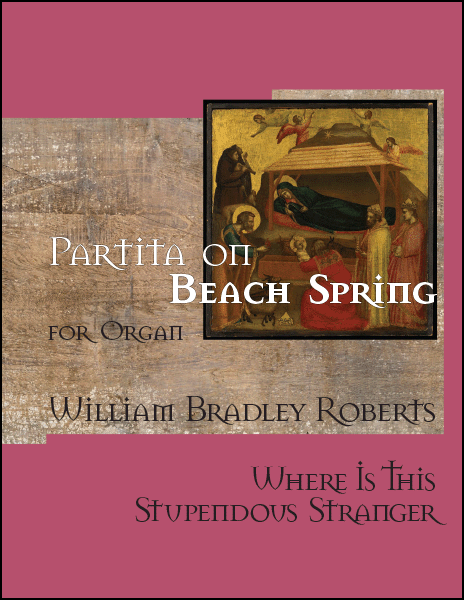|
Composer William Bradley Roberts
Released 6/22
Use Instrumental Length 9' 00"
Difficulty Moderately diff.
Catalog no. 160-657
Price $16.50 (U.S.)
Order now! 

Order PDF download!


Description
A five-movement work for organ, with an optional hymn setting in canon to be used in conjunction with the partita with the Christmas/Epiphany text "Where Is This Stupendous Stranger."
Movements
Hymn in canon 
I. Clog dance 
II. Trio Barocco 
III.
Jazz Chorale 
IV. Fife Tune 
V.
Fanfare and Toccata 
Recordings by Nathan Laube at the dedication of the Harrison and Harrison organ at Christ Church Episcopal in Alexandria, Virginia, January 2022, Jason Abel, Director of Music. Christ Church commissioned this partita for the dedicatory recital.
|
| |
|


Review
"A Partita and new harmonization of BEACH SPRING paired with the text 'Where Is This Stupendous Stranger'
was commissioned for the 2021 dedication of the new Harrison and Harrison organ at Christ Church, Alexandria, Virginia. Many early American hymns lend themselves to canonic treatment. Roberts' harmonization incorporates a canon in the tenor at the distance of one measure and suggests performance in canon for stanza two. This harmonization is also printed separately (without text) on three staves to aid organists in soloing out the left hand. An inventive and unusual set of variations follows, starting with a marked and vigorous 'Clog Dance' in triple meter and followed by a 'Trio Barocco,' an ornamented chorale with an accompaniment of triplets and an active bass line. Despite the texture and title, it sounds like a modern piece, not an old one. The following movements are a 'Jazz Chorale,' meditative and serene with poignant harmonies, and a scherzo-like 'Fife Tune.' That movement and the final 'Fanfare and Toccata' carry over some of the Jazz-inflected sensibilities of the middle movement within a diatonic context. Apart from a brief excursion to C-minor in the mixed-meter fanfare, the finale stays in the home key of F major throughout. The toccata is brilliant without being too difficult, and the coda brings back the fanfare theme and pushes the tempo to an exciting conclusion, recalling Gerre Hancock's improvisations in the final approach to an added-note choir over an incipit of the tune. This is a lively and appealing recital piece to demonstrate the colors of an organ of any size, which I believe was the intention." --AAM Journal, May/June 2023
|































